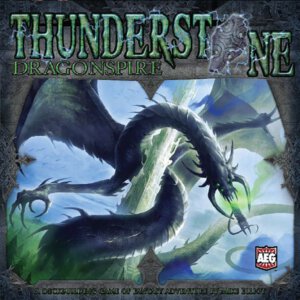
Designers: Mike Elliott and Brent Keith
Publisher: AEG
Year: 2011
Players: 2-5
Ages: 12+
Playing time: 45 minutes
MSRP: $45.99
Let’s begin by saying Dragonspire is a great new direction for Thunderstone. The game includes all new village cards, heroes, and monsters. Now you have plastic counters to track experience, as opposed to cards, and a new Setting mechanic has been added to the mix. Most interestingly, AEG decided to release a full-fledged game instead of just an expansion so you don’t need a copy of the original Thunderstone to play. All of the original basic cards have new artwork on top of the newly included cards for the Dragonspire release.
If gamers haven’t given Thunderstone a try, this release certainly is the place to start!
When you open the box you’ll find many enhancements to the look and feel of Thunderstone. You’ll find a new game board. While not being essential to playing the game – you didn’t need it previously – it is a welcome addition to the layout. The board has sections for the dungeon deck, the three monsters and a potential Guardian. The cards are pretty traditional sized, with a nice semi-gloss finish. By including new randomizers for all the cards, with different colored backing for every past card shows that AEG is committed to supporting the Thunderstone line and isn’t sitting on their laurels regarding previous releases. The plastic experience tokens are also nice and the box has more than enough of room for prior or future Thunderstone expansions.
One negative that needs to be mentioned is the rulebook. I don’t know what it is with a lot of game companies lately but, more often than not, any rulebook over four five pages in length just turns out to be one jumbled mess. One thing I have to mention, though, is the absolutely atrocious rulebook. Maybe it’s meant for people who are already familiar with the game, but it is bad. The book unnecessarily repeats itself. Not only is it filled with spelling and grammar errors but it does a terrible job of explaining many of the key features of the game.
I understand that many companies out there are terrified of using the tried and true “case system” method of rule writing, where you run across things like section 3 and then rules 3.1, 3.2 and so on. I suppose these companies don’t want an “ameristyle” tag hung on their title because they think it will turn off those gamers out there who are used to the free flowing “eurostyle” rule writing format. The latter style works well for games that only need three or four pages of explanation but games such as Thunderstone fairly demand the former rules presentation layout. The argument could be made that the rules are presented for those already familiar with Thunderstone because this is an expansion yet, since this is a free standing expansion without the need for any other purchases, that argument holds no water with me; the rules should spell everything out for new players to the Thunderstone system.
Let’s get back to the good…
Dragonspire brings new monsters, heroes, and village cards to the mix. A number of the new heroes have ways to manipulate your deck by permanently discarding a card from you hand for a onetime bonus. The new village cards bring new powers that are along the lines of what you would have found in previous Thunderstone expansions; some cards are more interesting than others and I’ll bet most players will appreciate the new Scout card, especially when they’re preparing to take on one of the bigger baddies in the dungeon.
I think the coolest new addition to the game is the Settings. These are major game changers because, if a Setting comes up, you’re not just questing for a Thunderstone. Each Setting has specific rules associated with it that change the way that particular game will play out. Since settings are randomized, like other cards, there’s no guarantee that your game will use one of the settings but when they do come into play they can add a nice new wrinkle. For an example, one of the Settings is the Dragonspire. With the Dragonspire in play, the dungeon deck is divided into two decks, each with a Thunderstone, and players are welcome to enter either.
With eleven new heroes, seven new monsters, eighteen village cards, and the addition of the Settings wrinkle, variations are nearly endless – especially if you have any of the other expansions or the base game. As Thunderstone has evolved the mechanics have been cleaned up and the game clicks along better than ever before. Even with the atrocious rulebook, this is a must buy for anyone who has yet to give this deck building game a shot, especially if they are looking for something with more depth and strategic planning than what they find in Dominion. For players who are well versed in Thunderstone already, the new cards and Settings as well as the cosmetic additions such as the experience tokens and playing board make this a no brainer purchase.
[rwp-review id=”0″]
- Chivalry & Sorcery Fifth Edition Reviewed - Nov 3, 2024
- Campaign Builder: Castles & Crowns Reviewed - Nov 2, 2024
- The Roleplaying Game of the Planet of the Apes Quickstart | First Look and Page-Through - Nov 1, 2024